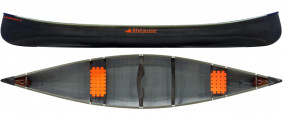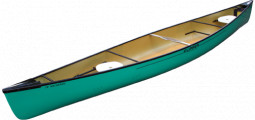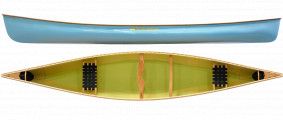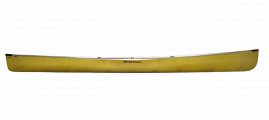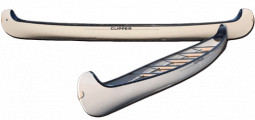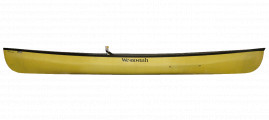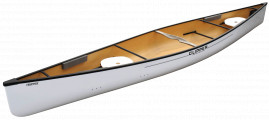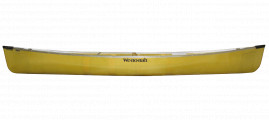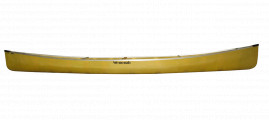Sit at the access point of any lake in canoe country on a summer afternoon and you’ll watch a steady stream of Kevlar canoes being effortlessly unloaded and placed on the water. These are the canoes of choice for paddlers who want a canoe they can carry just about anywhere.
If you’ve been canoe tripping for years, you’ve seen canoes evolve from wood canvas to aluminum, to fiberglass and eventually the Kevlar canoes that are so common today.
If you’re new to canoes, you’ve come at the right time. Kevlar and other aramids have revolutionized paddling, making canoes much lighter and easier to carry while still retaining some durability. They are perfect for taking backcountry trips on lakes and calm rivers, and also shine when being loaded onto a car.
If you think that a Kevlar canoe may be right for you, we have some advice that might help you finalize your decision. If you already know Kevlar is the way to go, scroll down to our Kevlar Canoe Buying Guide, as well as our picks of this year’s best canoes.
Top picks: Best Kevlar canoes for 2024
The following Kevlar canoes have received the highest star ratings by reviewers in our Paddling Buyer’s Guide. See and review all Kevlar canoes here.
Best Kevlar Canoes
Shop Kevlar canoes
Our Paddling Buyer’s Guide is a comprehensive guide to Kevlar canoe options. Whether you are looking for a tandem canoe for portage trips or a solo canoe for the cottage lake, we’ve got the specs, prices and reviews in our guide. Links within the guide will take you to dealers and places to buy the canoes.
Click the links below to view Kevlar canoes sorted by type and brand. If you aren’t sure where to start, keep scrolling through this article. We’ve got advice for buying a Kevlar canoe, answers to common questions and helpful tips for finding used boats.
Shop by type
Shop by brand
Shopping for a used Kevlar canoe?
Buying a used canoe is a great way to make the most out of your budget. The money you’ll save can go toward other important pieces of gear like a high-quality paddle or PFD. You’ll need to look hard to find a Kevlar canoe, as they often sell fairly quickly. The following pieces of advice are keys to getting a good deal on a high-quality canoe.
1 Don’t panic buy
We can’t stress this enough, especially among all the news of a boom in paddlesports interest coupled with supply chain disruptions. More people have been getting on the water and buying seemingly scarce canoes, but it doesn’t mean you need to pay full price on a used canoe. Pass up the highballing offers you see posted, more reasonable ones will come along. Waiting until the end of the season will mean that people may be selling boats they didn’t paddle that summer, or outfitters are clearing out stock.
Another potential issue is buying a Kevlar canoe that doesn’t meet your needs, just because it looks like a good deal. If you know you want an 18-foot lake cruiser, don’t buy a 15-foot solo canoe just because it’s cheaper. It’s not a good deal if you don’t end up paddling it.
2 Look everywhere
If you are looking for a Kevlar canoe for sale, Craigslist, Facebook Marketplace, Kijiji and other online classifieds are good places to start. Consider setting up notifications with the search terms “Kevlar canoe” to be notified whenever one is posted. On a general classified site like Kijiji, Kevlar canoes may be listed simply as “canoes” so take the time to inspect the photos and inquire.
Another great place to look is at an outfitter. Many outfitters sell off their rental fleets at the end of each season to buy new boats. Renting one in the summer is a good chance to try it out and use it in a real tripping scenario. Some outfitters may even put your name down so you can just pick it up in the autumn.
3 Know what to look for
When you are shopping for a used canoe, you should have an idea of what kind of boat you want. If you’re unsure, read our Kevlar Canoe Buying Advice below. When you go to see the boat, there are a few things to pay particular attention to. The first is how it was stored. Ultraviolet light from sun exposure can do serious damage to a canoe’s hull. It’s best if it has been stored in a roofed area. Spots where the hull has browned may indicate some UV damage.
Check the hull for any signs of abrasions or cracking. These will most likely occur at the bow and stern if the canoe has been paddled or dragged onto the shore. Many canoes made with Kevlar or other composites have float tanks; these airtight containers prevent the canoe from sinking if it fills with water. Listen for water sloshing around when you pick up the canoe. This is a telltale sign that water has entered the float tanks, which leads us to our next point:
4 Be willing to get handy
Kevlar and other aramid composite canoes are renowned for their lightness, and they are durable to a degree. If the canoe takes a hard impact, the epoxy will crack, exposing the woven cloth underneath.
If a used canoe is sold with a bit of damage, don’t worry. Kevlar canoes are quite easy to fix, and there are online guides to help you. You’ll be able to buy the necessary materials from your local hardware store or by contacting the canoe company directly. Learning to fix a canoe is a fulfilling experience that will get you excited about paddling your new canoe.
5 Be reasonable with the price
Kevlar canoes are some of the most expensive canoes on the market because of the cost of the materials and time it takes to build them. Their performance justifies the high price, and it holds true even with used ones. You will still be spending a fair amount of money, since canoes hold their value well. Even if it is years old, 50% of the original price is still a fair price for a well-cared for canoe. Don’t waste time trying to haggle and save a couple of bucks if you’re already getting a pretty good deal.
For more tips on what to look for when selecting a used canoe, read our article How To Buy A Used Canoe.
Kevlar canoe buying guide
If you’re on the fence about buying a Kevlar canoe, consider the following pieces of general canoe buying advice. We also have answers to common questions that will give you more insight into whether this is the right canoe for you.
1 Know what you want
There are lots of different canoe options, depending on the type of paddling you plan to do. Kevlar canoes are best suited for flatwater paddling on lakes and easy, deep rivers. The shape of the canoe changes how it feels in the water. Give particular attention to the rocker of the hull. This is the term for the end-to-end shape of the canoe. A canoe with lots of rocker will have a distinct “banana” shape, while one with little rocker will sit flat.
With lots of rocker, less of the canoe engages with the water, allowing it to pivot and turn easily. Canoes with little rocker travel straight exceptionally well, but don’t turn as readily. The side-to-side shape is important as well. Recreational canoes have very flat bottoms for additional initial stability.
2 Decide on the length
Canoes can be as short as 12 feet or as long as 20. Like the shape, different lengths meet different needs. Most solo canoeists will opt for a canoe of 15 feet or shorter. Sixteen feet is the sweet spot, where symmetrical canoes can be paddled solo or tandem. Anything longer than that, and you’ll want at least two paddlers in the boat.
16-foot tandem canoes are favored by river trippers. The shorter hull turns quicker, making the boat more responsive in moving water. Most people can pack for a one- or two-week trip in a 16-footer. Seventeen feet is a good length for a canoe that will be taken on a mix of rivers and lakes, with sufficient storage space for up to a month of gear and food.
Longer trips, or bigger water will demand an 18-foot canoe. These are also ideal for families with young children who can sit in the middle comfortably.
3 Compare materials
If you’re reading this page, you’ve been intrigued by the possibilities of a Kevlar canoe. These canoes are extremely light, making them easy to carry across portages. The downside of Kevlar is that it is not as durable as a plastic or fiberglass canoe, and they are quite expensive. If you are looking for durability, or to save a bit of money, maybe these other materials are better options:
Plastic
Pro: Cheaper than Kevlar and much more durable.
Con: Weighs nearly twice as much
Fiberglass
Pro: Lighter than plastic and cheaper than Kevlar. Unlike plastic, Fiberglass boats are stiff, performing better. Like Kevlar, they can be repaired fairly easily.
Cons: Heavier than Kevlar.
Carbon
Pro: Even lighter than Kevlar.
Con: More expensive and even more delicate. These boats are meant for exclusively flatwater paddling.
Aluminum
Pro: Indestructible, unless wrapped around a mid-river rock.
Con: Aluminum canoes are heavy, clunky, and quite difficult to find now that plastic canoes are widely available.
Wood
Pro: Timeless look and feel.
Con: Can be expensive, and they require lots of maintenance.
4 Look local
A good tip is to look around at what brands and styles of canoe are popular in the areas you frequent. They are going to be abundant for a reason, likely because they match the style of travel most common in that region. If there is a local canoe manufacturer, they will have tweaked their boats to the local waters. Buying a used boat through a local paddleshop is also a good opportunity to build a relationship and get advice from experts.
5 Try it out
The only way to know if a canoe is good for you is to give it a shot. Jump in and paddle, and you will quickly know if you are comfortable in that canoe or not. Because Kevlar canoes are so light, empty canoes feel very different compared to loaded ones. It may seem strange, but it is reasonable to bring a few items to load the boat and use as ballast.
Want to know more? Find our answers to common questions about Kevlar canoes below.
-
What is a Kevlar canoe?
A Kevlar canoe is a lightweight canoe made for easy carrying and smooth paddling. Kevlar is a type of aramid composite material, which resembles a woven cloth. This cloth is fitted to the shape of a canoe and sealed with a resin. The result is a stiff, reasonably durable canoe at a fraction of a plastic canoe’s weight.
-
Are Kevlar canoes worth it?
The savings in weight make Kevlar canoes well worth it. On a long portage would you rather carry 45 or 90 pounds on your shoulders?
-
Can Kevlar canoes sink?
Most Kevlar canoes have built in “float tanks” to prevent them from sinking. These are sealed compartments at the ends of the canoe that hold air. If the canoe fills with water, they will keep it afloat.
-
How long does a Kevlar canoe last?
If properly cared for, a Kevlar canoe can last a long time. The key is to store it properly to protect the hull from harmful UV rays. Ideally, store the canoe inside, or at least under some form of shade.
-
How much does a Kevlar canoe weigh?
Kevlar or other aramid canoes weigh less than their fiberglass counterparts. A 16-foot Prospector canoe made with aramid weighs around 45 lb/ 20.4 kg. These weights will differ slightly depending on the brand, design and modifications made to the canoe.
-
Kevlar vs carbon fiber canoe
Carbon fiber canoes are a price tier up from Kevlar canoes and weigh less. They forgo a thick epoxy finish to save additional weight, and so are not as durable. This makes carbon fiber a good choice for day paddlers or racers. Kevlar should be chosen for those taking trips, where the extra finish and subsequent weight is worth it for the added durability it provides.
-
Kevlar vs aluminum canoe
Comparing Kevlar and aluminum canoes is like comparing a sports car to a minivan. Kevlar canoes are significantly lighter and perform much better than aluminum, but at a higher price. Aluminum canoes are essentially indestructible, taking whatever beatings can be thrown at them, but they are not nearly as pleasant to paddle.
-
Kevlar vs fiberglass canoe
Kevlar is more expensive than fiberglass, but with the extra cost comes a reduction in weight and increase in performance. A 16-foot Kevlar canoe will weigh around 45 lbs/20.4 kg while a 16-foot fiberglass weighs around 66lbs / 30 kg. Both are made through similar processes, using woven cloth and resin, but Kevlar cloth is actually stronger and stiffer than fiberglass. It is more difficult to work with, and more expensive, which explains the higher price.
-
Kevlar vs Royalex canoe
Kevlar canoes are a preferred choice for flatwater tripping over the discontinued Royalex canoes. Royalex canoes were renowned for their ability to withstand repeated impacts and still survive. The downside is that they weigh a ton, making any portage gruelling. Kevlar canoes in contrast, wouldn’t last long pinned against a rock in a river.
You need not be in that situation though, because they are so light that portages are a breeze. A 16-foot Royalex/plastic canoe weighs up to 85 lbs/38 kg compared to 45 lbs/20.4 kg for a 16-foot Kevlar canoe.
-
How much does a Kevlar canoe cost?
Kevlar canoes cost anywhere from $2,500-$4,000 depending on the make, model and length of the canoe. They are some of the more expensive canoes on the market due to the materials and time it takes to make the boats.
-
Kevlar canoe durability
Compared to other canoe materials, Kevlar canoes are not as durable. They are, however, more durable than most people think. They can tolerate minor scrapes and bumps, but high-force collisions like running into a rock in current, or dropping the canoe, will likely do some damage. With the right materials, many holes in the canoe can be fixed.
-
Kevlar canoe maintenance
Kevlar canoes don’t require as much maintenance as wooden canoes, but they still need care. Keeping the boat clean, with water and a gentle soap will stop dirt from staining the canoe. A marine-grade, UV-resistant wax on the hull will protect from sun damage.
-
Kevlar canoe storage
It’s best to store a Kevlar canoe indoors, or if it is outdoors, under a canopy. This will protect it from UV damage, and snow. A tarp shouldn’t rest directly on the canoe, as it will trap moisture against the hull and could lead to mold. The canoe should be upside down and resting on the gunwales. This is to prevent warping or excessive pressure that may happen if the weight of the canoe is pushing on the hull.
-
Where to buy a Kevlar canoe
Kevlar canoes are available at any paddlesports retailer, where you will also have a chance to speak to knowledgeable staff. They can give you advice on the boats they offer. National outdoor chains like MEC and REI also carry Kevlar canoes. Find dealers and places to buy Kevlar canoes in our Paddling Buyer’s Guide.
-
Kevlar canoe price
The price of a Kevlar canoe can be $2,500-$4,000. This changes with the make, model, and length of the canoe.
Kevlar canoe reviews
Read reviews of Kevlar canoes to start your search. See what our expert staff liked about a given boat to better understand where it excels. This can help you find one that matches your needs, or narrow the search down.
- Canoe Review: Stellar Kayaks Dragonfly
- Mad River Malecite Ultralite Canoe Review
- Nova Craft Rob Roy Canoe Review



